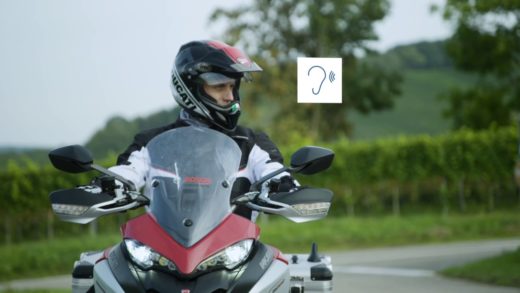
Digital safety shield: when motorcycles and cars talk to each other
New Bosch technology could prevent nearly one-third of all motorcycle accidents.
Connecting bikes and cars ensures motorcycles’ digital visibility
Dirk Hoheisel: “We are creating a digital safety shield for riders.”
Riders are 18 times more at risk of being killed in an accident than drivers
Bosch development project with partners Autotalks, Cohda Wireless, and Ducati
Stuttgart, Germany – The first warm days of the year mark the start of motorcycle season – and, unfortunately, a rise in the number of road accidents. Motorcyclists are among the most at-risk road users, 18 times more at risk of being killed in an accident than drivers. Last year, there were approximately 30,000 motorcycle accidents in Germany alone, roughly 600 of which were fatal. One of the main reasons is that riders of two-wheelers are often overlooked in road traffic, both at intersections and during passing. Bosch wants to change that. With its partners Autotalks, Cohda Wireless, and Ducati, it has developed a prototype smart solution. “We let motorcycles and cars talk to each other, creating a digital safety shield for riders,” says Dr. Dirk Hoheisel, a member of the Bosch board of management. The goal is to prevent dangerous situations from occurring in the first place.
Connectivity could prevent nearly one-third of motorcycle accidents
According to estimates by Bosch accident research, motorcycle-to-car communication could prevent nearly one-third of motorcycle accidents. “Through safety systems such as ABS and motorcycle stability control, Bosch has already made riding a two-wheeler significantly safer. By connecting motorcycles, we are taking safety to the next level,” Hoheisel says. Here is how it works: up to ten times a second, vehicles within a radius of several hundred meters exchange information about vehicle types, speed, position, and direction of travel. Long before drivers or their vehicles’ sensors catch sight of a motorcycle, this technology informs them that a motorcycle is approaching, allowing them to adopt a more defensive driving strategy. For example, typical dangerous situations arise when a motorcycle approaches a car from behind on a multi-lane road, ends up in a car’s blind spot, or changes lanes to pass. If the system identifies a potentially dangerous situation, it can warn the rider or driver by sounding an alarm and flashing a warning notice on the dashboard. In this way, all road users receive essential information that actively helps avoid accidents.
Vehicles exchange information within just a few milliseconds
The public WLAN standard (ITS G5) is used as the basis for the exchange of data between motorcycles and cars. Transmission times of just a few milliseconds between transmitter and receiver mean that participating road users can generate and transmit important information relating to the traffic situation. Parked or idling vehicles also transmit data to any surrounding receivers. To allow riders and drivers who are farther away to reliably receive the necessary information, the technology makes use of multi-hopping, which forwards the information automatically from vehicle to vehicle. In critical situations, therefore, all road users know what is happening and are able to take appropriate action in advance.
Video on motorcycle-to-vehicle communication: https://www.youtube.com/watch?v=BXXlodI9gO0
